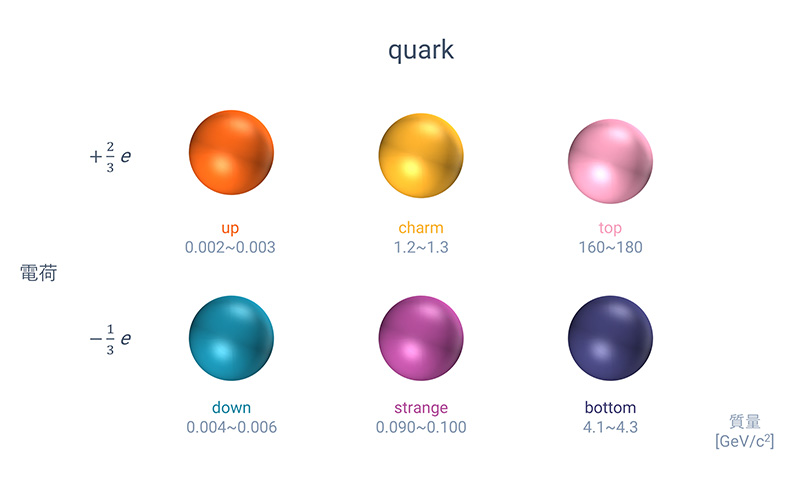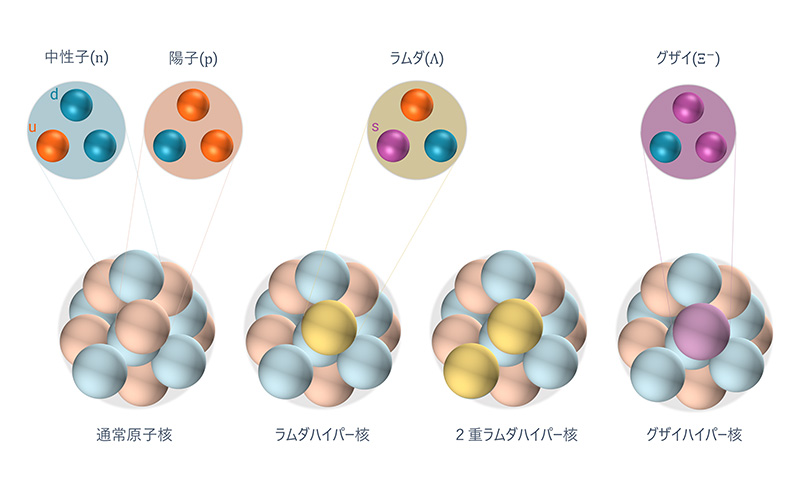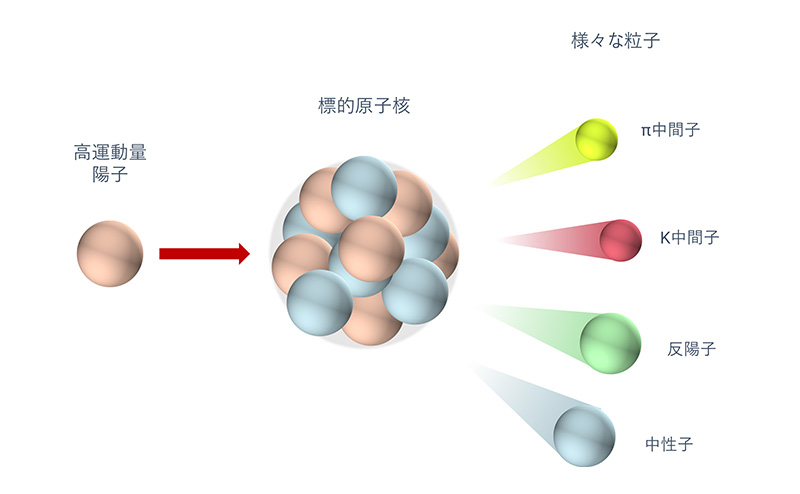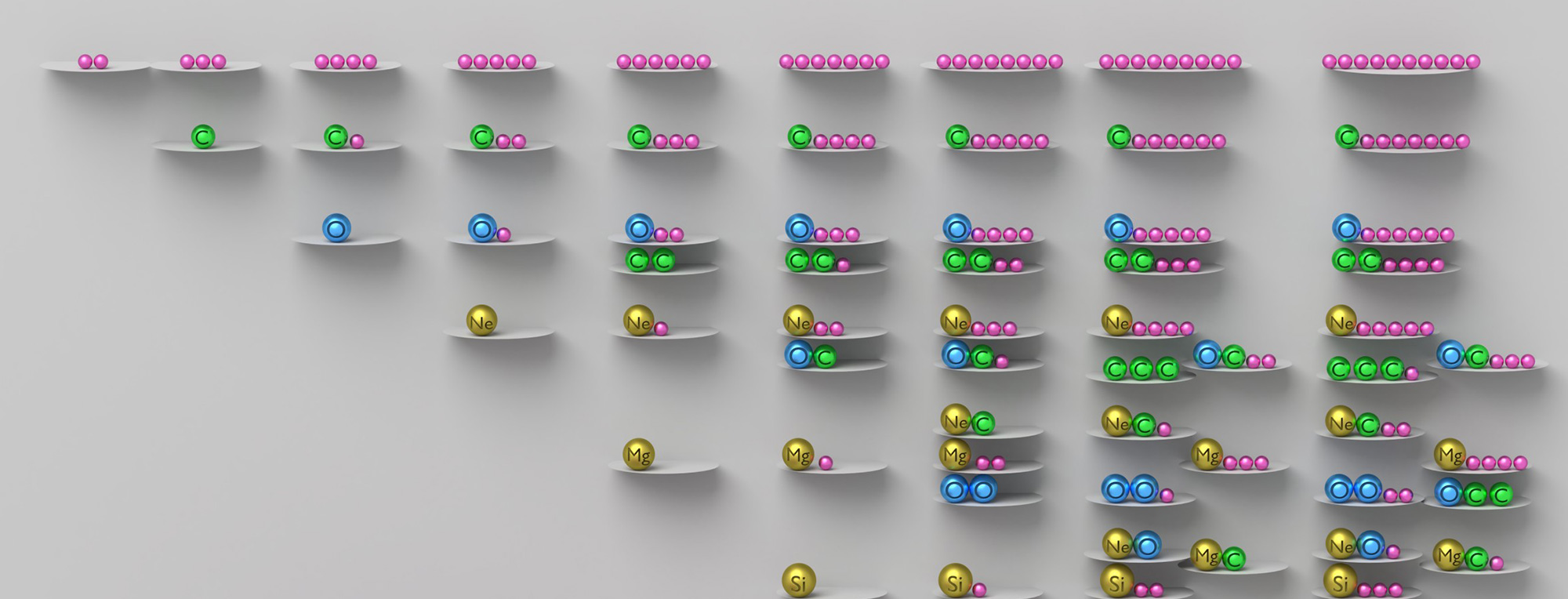What's strangeness?
Atomic nuclei in nature are normally made up of nucleons such as protons and neutrons. These nucleons are consisting of only two kinds of elementary particles: up/down quarks.
However, there are a total of six kinds of quarks in this world as shown in Fig. 1, not just these two. The remaining four kinds are heavier and more unstable than the up quark (u quark) and down quark (d quark), and rapidly change to the lighter quarks such as u/d quarks (this is called "decay").-

Fig.1: Six kinds of quarks.
So what is the next lightest quark after the u quark and d quark? It is the strange quark (s quark). Nucleons in which some of the u/d quarks are changed to the s quark are called hyperons (Λ, Σ, Ξ). Hyperons are a kind of baryons, which is a family of nucleons. Typical examples of the baryons are shown in Fig. 2. In addition to the baryons presented in Fig. 2, various particles are composed of combinations of u, d, and s quarks such as K meson (Kaon), which consists of an s quark and a u/d quark.
Strangeness nuclear matter, which is nuclear matter containing such strangeness particles, is the subject of our research. Figure 3 shows a typical example of strangeness nuclear matter called "hypernuclei" in which hyperons contain in nuclei.
-

Fig.2: Typical examples of baryons.
-

Fig. 3: Atomic nuclei and hypernuclei.
What you can know from the strangeness.
Atomic nuclei and electrons are attracted each other through the electromagnetic interaction. This enables electrons to surround nuclei, and thus atoms can be formed.
What about the case of nuclei, which are formed by protons and neutrons?
There are four kinds of fundamental interaction in the natural world. The interaction between protons and neutrons is the strong interaction called the nuclear force. Since the strong interaction is attractive force and its strength is about 100 times stronger than the electromagnetic interaction, protons and neutrons can form nuclei.
Now the question is, how the strong interaction acts in the strangeness nuclear matter? Acts as an attractive force same in the nuclei, or repulsive force? How much the strength?
We are aiming to obtain keys for these interesting mysteries with new experiments and to understand properties of the strong interaction which governs the material world.
Experimental methods
How can we study properties of the strangeness nuclear matter?
First of all, we need to prepare a large amount of the strangeness nuclear matter. To do so, we mainly use a large-scale accelerator at Japan Proton Accelerator Research Complex (J-PARC) in Tokai-mura, Ibaraki prefecture.
When a high-momentum beam extracted from the aceelerator bombards nuclei in a target, various particles are generated with the strong interaction such as pions and Kaons as shown in Fig. 4. The strangeness nuclear matter can be produced by these particles. J-PARC is one of the most suitable facilities in the world to study the strangeness nuclear matter because the world class intensity of the Kaon and pion beam are provided in J-PARC.
The next step is to observe the produced strangeness nuclear matter. Since the s quarks rapidly decay into the lighter quarks (u/d quarks), we should take various methods and ideas to observe the s quarks. Precise measurement on the energies and momenta of particles involved in the production of hypernuclei is one of the useful tools to study the properties of hypernuclei (especially the interaction between hyperons and nucleons).
-

Fig. 4: Descriptive sketch of particle production.
J-PARC E70 experiment
We introduce here the E70 experiment, a spectroscopy of Ξ hypernuclei.
Ξ particle is a baryon (a member of nucleons) which contains two strange quarks. The E70 experiment is aim to obtain information about interaction between the Ξ particle and nucleon (ΞN interaction) by the spectroscopy of the missing mass of the Ξ hypernuclei in which the Ξ particle is bound in a nucleus. A conceptual diagram of the E70 experiment is shown as Fig. 5.
Only a few experimental information on nuclei containing two s quarks are available to date. In addtion, there is no example of a bound state of Ξ hypernuclei observed as a peak. If a peak structure corresponding to the bound state of Ξ hypernuclei is observed, we can obtain valuable information on the ΞN interaction. We are trying to make the first observation of the bound-state peak by improving the energy resolution compared to previous experiments with the high-resolution spectrometer S-2S (see Fig. 6) and the active target at J-PARC where we can use a high-intensity Kaon beam.
Currently, we are working on developing detectors and updating analysis methods for the beam time in 2022.
-

Fig.5 : Conceptual figure of the E70 experiment. A bound state of ^11B and Ξ-, namely ^12_Ξ Be nuclei, is searched in the E70 experiment. The missing mass is deduced by measuring the momenta of the incident K- and scattered K+.
-

Fig. 6: Dipole magnet S-2S.
-

Fig. 7: Nice photo of test experiment for the active target.
